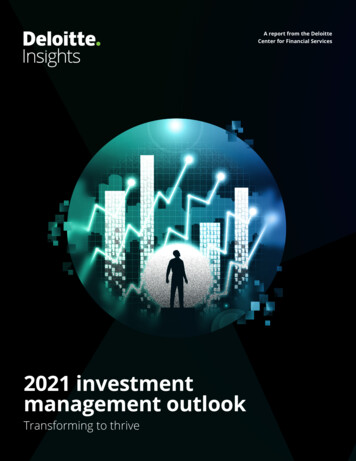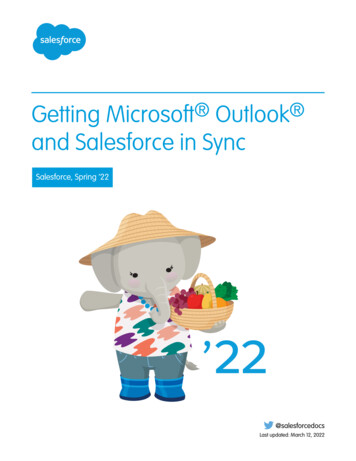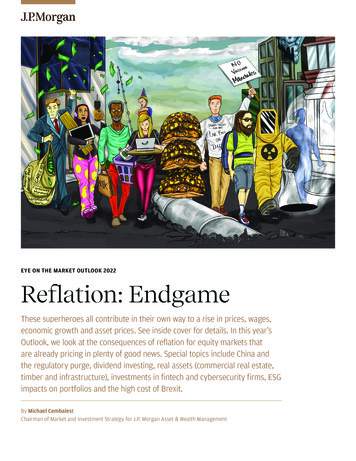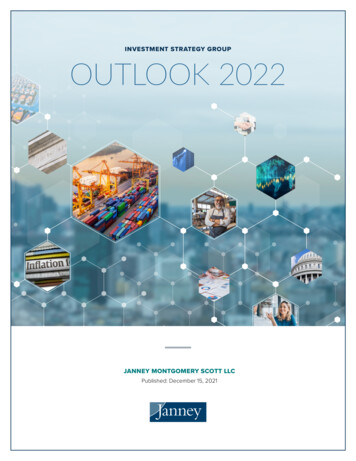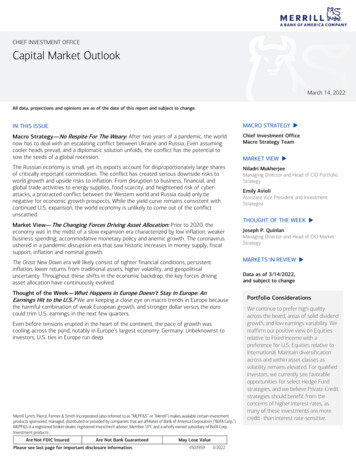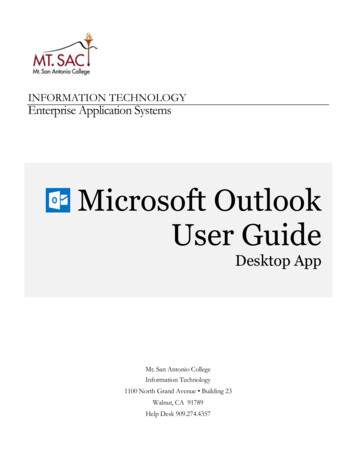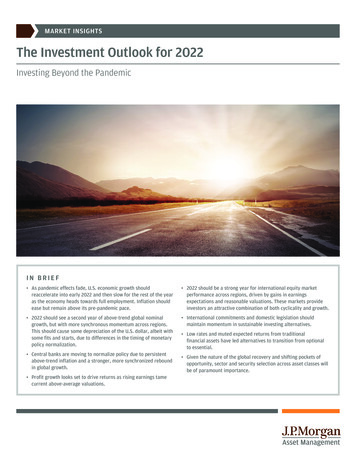
Transcription
MARKET INSIGHTSThe Investment Outlook for 2022Investing Beyond the PandemicIN BRIEF As pandemic effects fade, U.S. economic growth shouldreaccelerate into early 2022 and then slow for the rest of the yearas the economy heads towards full employment. Inflation shouldease but remain above its pre-pandemic pace. 2022 should be a strong year for international equity marketperformance across regions, driven by gains in earningsexpectations and reasonable valuations. These markets provideinvestors an attractive combination of both cyclicality and growth. 2022 should see a second year of above-trend global nominalgrowth, but with more synchronous momentum across regions.This should cause some depreciation of the U.S. dollar, albeit withsome fits and starts, due to differences in the timing of monetarypolicy normalization. International commitments and domestic legislation shouldmaintain momentum in sustainable investing alternatives. Central banks are moving to normalize policy due to persistentabove-trend inflation and a stronger, more synchronized reboundin global growth. Profit growth looks set to drive returns as rising earnings tamecurrent above-average valuations. Low rates and muted expected returns from traditionalfinancial assets have led alternatives to transition from optionalto essential. Given the nature of the global recovery and shifting pockets ofopportunity, sector and security selection across asset classes willbe of paramount importance.
THE INVESTMENT OUTLOOK FOR 2022INTRODUCTIONTwo years ago, the U.S. and global economies were rocked bytwo enormous shocks — the pandemic and the policy response.These two shocks triggered giant waves in economic output,employment and inflation and simultaneously suppressedinterest rates while supporting very strong gains in assetprices. However, these waves are now subsiding. For investors,the key to investing in 2022 and beyond is to navigate what isleft of these waves and, more importantly, to see how theyhave altered the financial landscape.DIMINISHED PANDEMIC IMPACTS SHOULD PUSHTHE U.S. ECONOMY TO ITS CAPACITY LIMITSOn the pandemic itself, there are reasons for cautiousoptimism. The death toll has been horrific with over 800,000Americans now having perished from the disease. However,we estimate that a combination of vaccinations and infectionshas left close to 90% of the country with some immunity toCovid-19 and daily fatalities have fallen to roughly 1,000 asthe Delta wave has subsided. New variants threaten the worldwith a further resurgence in cases. However, the history ofprior pandemics suggests that, even without widespreadvaccinations, viruses tend to mutate to become morecontagious but less deadly, which should allow society to slowlyreturn to normal. In addition, from an economic perspective,much of the economy has adapted to a pandemic environment,allowing certain industries to thrive even as some remaindepressed due to health concerns.Exhibit 1: Fatalities from Covid-19 should fade in 2022,helping society move on from the pandemic7-DAY MOVING AVERAGE300,000 Confirmed casesFatalities 00100050,0000Feb ’20500May ’20Aug ’20Nov ’20Feb ’21May ’21Aug ’210Nov ’21Source: Centers for Disease Control and Prevention, Johns Hopkins CSSE, J.P. MorganAsset Management. Data are as of December 7, 2021.2T H E IN V ES T MEN T O UTL O O K F O R 2 02 2As the pandemic fades, the extraordinary fiscal supportprovided by the federal government is also diminishing. As thisis being written, the Infrastructure Bill has been signed intolaw while the House has passed a version of a reconciliationbill that contains an extension of various tax credits, fundingfor many climate change initiatives and tax increases oncorporations and wealthy families. The details of the final actwill have to be negotiated between the House and the Senate.However, even if a bill close to the House bill is passed, the netimpact of these two pieces of legislation would likely boost thebudget deficit in fiscal 2022 by less than 200 billion comparedto the 5.3 trillion added to federal deficits by previouscoronavirus relief measures over the past two years.Following a better than 6% annualized gain in the first halfof the year, real GDP growth slumped to just 2.1% in the thirdquarter, as supply-chain issues impeded both production andconsumer spending. This was particularly notable in lightvehicle sales, which fell from an annualized 16.9 million unitsin the second quarter to just 13.3 million units in the third.However, the fourth quarter has seen signs of improvement insupply chains with rising auto production, smaller backlogs atports, increased hiring of truck drivers and fewer purchasingmanagers reporting slower deliveries. This should allow pentup demand to boost spending over the next few months. Inaddition, while government aid has diminished, consumerspending should be supported by massive gains in householdnet worth and lower debt service costs. Capital spending andinventory rebuilding should also contribute to growth, financedby strong profits and low interest rates and motivated by laborshortages and high margins. Because of this, we expect realGDP growth to exceed 5% annualized over the fourth and firstquarters combined before subsiding to a near 2% pace by theend of 2022, as labor constraints act as a more significant dragon economic momentum.The labor market saw huge improvement over the course of2021, with the unemployment rate falling from 6.7% inDecember 2020 to 4.2% by November 2021 with the additionof 6.1 million non-farm payroll jobs. However, even with this,payroll employment remains 3.9 million below its peak inFebruary 2020. Equally significantly, the labor force is 2.4million people smaller than it was in February 2020, with thelabor force participation rate falling from 63.3% to 61.8%.This statistic needs to be treated with some caution however,as it partly reflects the continued retirement of baby boomers.A more serious issue from an economic perspective is thatthe U.S. population aged 16-64 has fallen by 465,000 sinceFebruary 2020 and is likely to fall further in 2022 due to theaging of the baby boom cohort and very limited immigration.
THE INVESTMENT OUTLOOK FOR 2022This lack of labor supply combined with strong economicgrowth should allow unemployment to decline rapidly in theyear ahead, with the unemployment rate falling below 4% bythe middle of the year. This should be accompanied by stronglyrising wages as companies compete to hire and retain a limitedsupply of workers.Rising wages, in turn, should continue to add to inflationpressures in the year ahead. However, CPI inflation, havingexceeded 6% for the first time in over 30 years in the fourthquarter of 2021, should ease on average in 2022 as oil pricesrecede, supply chain difficulties diminish and government aidto low- and middle-income households dries up. Still, withstrong wage growth, high inflation expectations and the laggedeffect of higher home prices on rents, we expect inflation asmeasured by the core consumption deflator to remain solidlyabove 2% by the end of 2023.Exhibit 2: Very strong labor demand should continue toreduce unemployment and boost wagesSEASONALLY ADJUSTED, PERCENT16% Unemployment rate 6.3% Wage growth4.0%14%12%10%Apr. 202014.8% 50-year avg.May 19759.0% Nov. 198210.8% Oct. 200910.0% Jun. 19927.8% 8%Jun. 20036.3% 6%Nov. 8’92’96’00’04’08’12’16’20Source: BLS, FactSet, J.P. Morgan Asset Management. Data are as of December 7, 2021.INTERNATIONAL ECONOMY: FADING PANDEMICSTORM SHOULD PERMIT REGIONS TO SWIM IN THESAME DIRECTIONAs 2021 comes to a close, the global economy is registeringsolid momentum, with 88% of countries having a compositePMI over 50 in November versus only 71% in August. 2022looks to be a second consecutive year of above-trend growthfor the international economy, but with a key difference versusthis year: more coordinated acceleration of momentum acrosssectors and regions. The global economy recovered to its prepandemic level of real output already in 4Q20, but since thenpandemic waves have hit different regions at different timescausing variation in when sectors and regions were ebbing andflowing. We may yet see a few more months of uneven growthas a winter wave of Covid-19 causes some fall in mobility inEurope, while growth accelerates in Japan and Southeast Asiaas they leave behind their previous Covid-19 waves.However, as 2022 progresses, the global economy should leavethe storm of the pandemic behind due to a combination ofnaturally acquired immunity, accelerated vaccination rates,expected introduction of oral anti-viral pills and abandonmentof “zero tolerance” approaches to the virus (with Chinapotentially joining other Asian countries in doing so later in theyear). By sector, services should register the strongest growthrates, with travel, leisure and hospitality finally returning totheir pre-pandemic levels as households enjoy their sustainedmobility, with spending supported by previous fiscal supportand continued strengthening of labor markets. The hand-off ofthe baton from goods to services spending should ease thepressure on global supply chains, allowing businesses tore-stock their inventories. While for some items it may take thebetter part of the year for a full return to normal, incrementalprogress should support growth early on, as supply disruptionsmight have peaked in the third quarter. Lastly, the Chineseeconomy’s ability to find its footing will be key. Following itsdeceleration in the second half of 2021, growth should returnto China’s new normal growth rate of near 5% early next yeardue to some targeted monetary and fiscal easing, as well asmore visibility on the direction of reforms.In addition to above-average global growth, 2021 is endingwith above-average inflation, with only China and India seeingbelow-average inflation. September’s pop of 3.7% in globalconsumer prices (versus the 10-year average of 2.4%) isexplained by higher than normal growth rates of energy, foodand core goods prices. Throughout 2022, inflation shouldgradually normalize as the year-over-year comparison forJ.P. MORGAN ASSE T MA N A G E ME N T3
THE INVESTMENT OUTLOOK FOR 2022energy and food prices becomes more challenging and aseasing supply disruptions bring down goods prices. On theother hand, services prices should move higher due to thefading of the pandemic storm, keeping core inflation ratesstill somewhat elevated until the end of the year. By then,more structural disinflationary forces, such as technology,demographics and income inequality, should reassert theirdominance. Ultimately, the new range for inflation this cyclewill vary by country, depending on whether more structuralforces like wages have turned (with more muted signs of this incontinental Europe and Japan) and the extent to which inflationexpectations have become unmoored (which will depend oncentral banks’ policy credibility, more so an issue for someemerging market high yield countries).Overall, above-trend global nominal growth shouldcharacterize the year ahead. The more coordinated nature ofthe acceleration should cause some depreciation of the U.S.dollar, as capital flows to other markets looking for bettervaluations and returns ahead in this cycle. With that said, someexceptions of dollar strength can be expected during the year,as investors focus on some central banks lagging behind theinterest rate normalization trend, especially those of Europeand Japan. Overall, the expected broader depreciation of theU.S. dollar should provide a currency boost to internationalreturns for U.S. dollar-based investors.Exhibit 3: As 2021 comes to a close, countries areaccelerating more in sync% OF COUNTRIES WITH COMPOSITE PMI OVER 50, 3-MONTH MOVING AVG.100%90%80%70%60%50%40%30%20%10%0%’07 ’08 ’09 ’10’11’12’13’14 ’15’16’17’18’19’20 ’21Source: Markit, J.P. Morgan Asset Management. Data are as of December 7, 2021.4T H E IN V ES T MEN T OUTL O O K F O R 2 02 2Exhibit 4: Global CPI should gradually normalize as thepop in energy and core goods fadesYEAR-OVER-YEAR % CHANGE4.5%25.0% Headline Core Goods Core Services 14’15’16’17’18’19’20’21-20.0%Source: J.P. Morgan Global Economic Research, J.P. Morgan Asset Management.Data are as of December 7, 2021.FIXED INCOME: RATE HIKES? NOT SO FASTAs pandemic conditions recede globally, we are likely to movepast peak monetary policy accommodation as developedmarket (DM) central banks respond, in varying degrees, topersistent above-trend inflation and a more synchronizedrebound in global growth next year. All major DM central bankshave had to acknowledge the reality of, and expectations for,higher inflation, and how they respond in 2022 will be criticalfor markets.We believe central bank policy response will depend on policyflexibility toward higher inflation and broader economicconditions. To be clear though, inflationary pressures arerunning above target everywhere (with the exception of Japan)and, as highlighted in Exhibit 5, investors firmly believe mostcentral banks should begin hiking rates next year, while thepace at which central banks tighten policy through 2023 andbeyond is up for debate. The Federal Reserve (Fed), Bank ofEngland (BoE), Bank of Canada (BoC) and Reserve Bank ofAustralia (RBA) are all expected to start hiking, while theEuropean Central Bank (ECB) and Bank of Japan (BoJ) haveclearly positioned themselves more dovish, in large part due toa historically ultra-dovish policy and pandemic conditions thatcontinue to cause economic activity to ebb and flow.
THE INVESTMENT OUTLOOK FOR 2022Exhibit 5: Generally, central banks are expected to quicklylift rates over the next two years, but proceed with cautionafter 2023GLOBAL OIS CURVES, %2.5% Fed BoJExhibit 6: Markets anticipate aggressive hiking cycles in2022 due to persistent elevated inflationDERIVED FROM OIS CURVES7 BoE ECB RBA �25’26’27’28’29’30’31Source: Bloomberg, J.P. Morgan Asset Management. The curves represent therespective currency denominated overnight index swap rates. Fed Federal Reserve;BoJ Bank of Japan; BoE Bank of England; ECB European Central Bank; RBA Reserve Bank of Australia; BoC Bank of Canada. Data are as of December 7, 2021.With that said, while we acknowledge central banks will be onthe move next year, we still believe markets are too aggressivein their expectations for interest rate hikes and we expectcentral banks to tilt slightly more dovish and not overreact tohigh inflation. We think central banks will remain morecautious for a few reasons:1. It’s generally accepted among central bankers that thecurrent bout of inflation is mostly transitory, driven by risingenergy prices and supply chain pressures, both of whichshould begin to moderate next year.Source: Bloomberg, J.P. Morgan Asset Management. Fed Federal Reserve; BoJ Bank of Japan; BoE Bank of England; ECB European Central Bank; RBA ReserveBank of Australia; BoC Bank of Canada. Data are as of December 7, 2021.This dynamic suggests investors should look to shortenduration within their core bond portfolios. Moreover, asgrowth rebounds, credit fundamentals should continue to besupported as default rates will likely remain at multi-year lows.Investors are being compensated at current spread levels forthe minimal credit risk in markets; however, further spreadcompression will be hard to come by. Lastly, emerging market(EM) debt could provide opportunities as many EM centralbanks have already begun hiking rakes to ward off higherinflation and to defend their currencies, allowing for moreattractive valuations relative to DM rates.2. Monetary policy acts with a significant lag, and policymakersrecognize a tightening in rates today could lead to asoftening in aggregate demand just when the post pandemiceconomic surge is fading.3. A slower than anticipated pickup in vaccination ratesglobally could lead to another wave in cases, challenging thegrowth outlook.For investors, as central banks shift to less accommodativepolicy, we expect this will lead to steeper curves driven byrising long rates as markets recognize that DM central bankswill be more gradual in hiking rates, therefore not restrictingthe rebound in economic activity. More directly, over thecourse of 2022, we expect the ECB and BoJ to remain on hold;the Fed and RBA to hike once; and the BoC and BoE to deliver2-3 hikes, much less aggressive than current market pricing(Exhibit 6).J.P. MORGAN ASSE T MA N A G E ME N T5
THE INVESTMENT OUTLOOK FOR 2022EQUITIES: FOLLOW THE EARNINGS IN 20222020 saw the equity market move higher against a backdrop ofrising earnings expectations and declining valuations. However,with the U.S. equity market now sitting close to its all-timehigh, many investors are asking what is in store for 2022. Byour lights, the coming year should see earnings act as theprimary driver of returns as the U.S. equity market continuesto grow into its above-average valuation.Earnings growth has been nothing short of spectacular in 2021,with Standard & Poor’s currently estimating that S&P 500operating earnings per share grew by 70%. The majority of thisearnings growth came from margin expansion, as companiescut costs aggressively during the pandemic and subsequentlybenefited as revenues came roaring back earlier this year.Alongside this rebound in revenues, however, has been acontinued increase in input costs and wages. This has led toconcerns that profit margins may come under pressure nextyear and potentially lead earnings to decline.80%Share of EPS growth2021* Avg.’01-2060% Margin Revenue Share count Total EPS51.7%17.0%-0.9%67.8%19% 19%20%24%15%13% %22%4%-40%’01 ’02 ’03 ’04 ’05 ’06 ’07 ’08 ’09 ’10 ’11 ’12 ’13 ’14 ’15 ’16 ’17 ’18 ’19 ’20 ’21Despite these rising costs, however, companies may be able todefend their margins in two different ways. First, we havealready seen companies pass along higher prices to the endconsumer — while there are implications for inflation, this doeshelp preserve profitability. At the same time, we have seenmore and more managements mention a focus on productivityand efficiency. Historically, capital spending tracks earningsgrowth with a 12-month lag; this suggests that businessinvestment may accelerate next year, helping offset risinginput costs in a more sustainable way.T H E IN V ES T MEN T OUTL O O K F O R 2 0 2 2Financials0.350.29 Growth Value0.280.22Energy0.21Real Estate0.15Cons. Disc.0.13Cons. : FactSet, FTSE Russell, J.P. Morgan Asset Management. Data are as ofNovember 30, 2021.Source: FactSet, Compustat, Standard & Poor’s, J.P. Morgan Asset Management.Data are as of November 30, 2021.60.810.45Health Care-0.1-22%-40% -31%IndustrialsComm. Svcs.*Utilities-11%-20%1Q 2009 - 2Q 2021MaterialsANNUAL GROWTH BROKEN INTO REVENUE, CHANGES IN PROFIT MARGIN& CHANGES IN SHARE COUNT47%Exhibit 8: Investors should focus on sectors with earningsthat are sensitive to growthInfo. Tech.Exhibit 7: Margins may come under pressure in 202240%With economic growth set to remain above trend and earningslikely to be the primary driver of returns, we prefer thosesectors and industries with earnings that are most sensitive tothe underlying pace of economic activity. Importantly, this doesnot mean investors have to choose between value or growth —the best allocation will actually be a blend of the two. Earningsof companies in the technology, communication services,financial and industrial sectors have historically been mostcorrelated to changes in real GDP; furthermore, we believe thatthe financial sector could benefit from higher interest ratesand a resumption of buyback activity.The emergence of the Omicron variant has reminded us thatthe pandemic is not yet behind us, and volatility could remainelevated into the end of 2021 and beginning of 2022. However,a balanced approach to equity investing that is focused onearnings seems to be the optimal strategy in an environmentof continued uncertainty.
THE INVESTMENT OUTLOOK FOR 2022INTERNATIONAL EQUITY MARKETS:BALANCING CYCLICAL RECOVERY AND STRUCTURALGROWTH EXPOSURE2022 should be a strong year for international equity marketperformance across regions, driven by solid fundamentals andreasonable valuations. 2021’s strong nominal economic growthhas translated to a surge in international earnings growth of51% year-over-year this year (represented by the MSCI AllCountry World Index ex-U.S.). While the outlook for 2022includes another year of above-average nominal economicgrowth, consensus earnings expectations for next year are ofmodest 7% growth (right in line with the 20-year average),suggesting room for earnings expectations to move higher.In addition, international valuations (represented by thenext 12 months’ price-to-earnings ratio) have contracted asubstantial 14% this year, leaving less room for multiplecontraction next year. In addition, the discount versus theU.S. is still at record highs (three times the average discountof 10%).As the global recovery continues in 2022, cyclically orientedinternational markets offer investors exposure to strongearnings growth in sectors like energy, materials, industrialsand financials. In particular, the strongest cyclical bang forthe buck can be found in Europe and Japan, where cyclicalsectors make up 55% of the market. In addition, theseinternational markets also offer investors a hedge againstinflation, a topic that will remain under debate for the betterpart of next year. In particular, financials and materials canoffer an inflation hedge, as the banking sector benefits fromsteepening yield curves and the mining sector benefits fromhigh commodity prices.As the year progresses and the global economy goes fromrecovering to recovered, it is also key to focus portfolios onstructural post-pandemic growth opportunities. These includethemes like technological innovation, the growth of the EMmiddle class and the global push for decarbonization. Theseare themes that can be found across regions, for example inhard-technology companies listed in China, Korea and Taiwan;luxury goods companies listed in Europe that derive themajority of their revenue from emerging consumers; andrenewable energy and electric vehicle companies listed inEurope and China. While international markets are still morecyclical than U.S. ones, the representation of more growthoriented sectors has grown over the past decade, offeringinvestors the sweet spot of cyclicality and growth in thesebetter-valued international markets.Exhibit 9: International markets are still cyclical, butincreasingly offer access to growth tooCHANGE IN SECTOR WEIGHTINGS, % POINT CHANGE FROM DEC. 31, 200515% EM EAFE10%8%5%5%4%5%3%1% alsIndust.OtherTechHealth Care ConsumerSource: MSCI, J.P. Morgan Asset Management. Data are as of December 7, 2021.Lastly, Chinese equity markets will likely find their footing asinvestors feel more comfortable around the visibility of thislatest reform cycle, turning China from a big drag on EMreturns this year to potentially a big boost to it in 2022.Looking at historical episodes of reform cycle-induced 30%plus corrections in Chinese markets (2011, 2015 and 2018),markets have been positive on average 28% six months afterthe market trough. While reforms are unlikely to be rolledback, investor confidence about the end of surprises shouldhelp the market find its footing sooner rather than later.Returning inflows to Chinese markets since September is anencouraging early sign.J.P. MORGAN ASSE T MA N A G E ME N T7
THE INVESTMENT OUTLOOK FOR 2022ESG: SUSTAINED MOMENTUMInvestor appetite for ESG investing has continued to grow,with roughly one-fifth of net new flows in the U.S. going intosustainable strategies in 2021. As policymakers, consumers,corporations and regulators coalesce around a goal to achievea more sustainable future, we are likely to see massive changeover the next several decades — change that can drive longterm opportunities for portfolios. Policymakers began settingthe stage for that change with climate negotiations that willcarry into 2022.Global policymakers convened at the U.N. Climate ChangeConference (COP26) in November to cement the details of the2015 Paris Agreement, to strengthen commitments to net zerogreenhouse gas emissions and to mobilize financing. Thesummit yielded mixed success, with commitments to reducemethane emissions, to “phase down” coal, to halt and reversedeforestation and to finance the transition to net zero throughgreater public and private investment. However, the primarygoal, to strengthen net zero targets, was essentially postponedto late 2022 when countries are expected to further revisetheir commitments, placing a heavy emphasis on COP27 inEgypt in 2022.Although the U.S. is unlikely to revise its commitment ofcutting emissions by 50% by 2030, lawmakers did proposespending to work toward that target. The 1.2 trillioninfrastructure package includes funding for infrastructureresiliency, 15 billion for electric transport and 6 billion forWestern water infrastructure, and a reconciliation packagecould include up to 555 billion for clean energy tax creditsand clean technology. This would represent the largest climatecommitment the U.S. has made yet.While that is a start, the public sector globally will likelystruggle to accelerate net zero efforts further in 2022, shiftingfocus to the private sector for financing and innovation. Thereis evidence this is underway; global sustainable debt issuancedoubled in 2021 to nearly 1.5 trillion, and venture capital hadits strongest year ever for climate tech. This presents attractivelong-term opportunities for investors in both the publicand private markets and across equity, fixed income andalternatives. Key beneficiaries are likely to be industrials,utilities, technology and transportation, and the opportunitieswill be global, in Europe and even China. However, just as thetransition to a more sustainable future will be a multi-decadeone, investors should likewise be patient, selective and activein ESG investing as the landscape evolves.8T H E IN V ES T MEN T OUTL O O K F O R 2 0 2 2ALTERNATIVES: ALTERNATIVES ARE NOLONGER OPTIONALAlternative assets and investment strategies continue totransition from optional to essential. As laid out in our 2022Long-Term Capital Market Assumptions, the expected returnfor a 60/40 stock/bond portfolio over the next 10 to 15 yearsis a mediocre 4.3%, well below what many investors will needto generate in order to achieve their long-term goals. Againstthis backdrop, we see opportunities across the spectrum ofalternative assets and strategies to generate income, enhancereturns and further diversify portfolios. As always, however,we advocate for an outcome-oriented approach; first,investors need to determine the challenge they are workingto address and then determine the asset that will provide theintended solution.When it comes to generating income, core real assets arethe first place to look. The commercial real estate sector hascontinued its uneven recovery in 2021, with vacancy rates inthe industrial and multi-family housing sectors sitting at ornear their lows. On the other hand, the office and retail sectorscontinue to come back online as workers return to the officeand shoppers return to the stores. The coming year should seea continued recovery in these sectors as the pandemic fadesinto the background.Exhibit 10: The pandemic has impacted different real estateassets in different waysPERCENT20% Apartment Industrial Office 2’14’16’18’20Source: NCREIF, J.P. Morgan Asset Management. Data is based on availability as ofNovember 30, 2021.
THE INVESTMENT OUTLOOK FOR 2022Infrastructure assets continue to look attractive in a low-rateworth, particularly given the risk that inflation remainselevated over the medium term — many of these assets canpass along any increase in cost to the end consumer to protecttheir return on equity from higher input prices. Meanwhile,transportation assets should continue to benefit from supplychain disruptions, whereas other real assets like timber cangenerate income and help offset carbon emissions in a worldwhere sustainability is increasingly in focus. Finally, forinvestors that need more liquidity, covered call and strategicincome strategies can help solve the income conundrum.Private equity investors continue to embrace technologycompanies despite elevated valuations, and this shouldcontinue in 2022. However, it would not be surprising to seean increase in activity in those sectors hit hardest by thepandemic, particularly if it does fade over the course of thecoming year. Private credit, and particularly direct lendingstrategies, are another way of generating income; furthermore,while the leveraged loan market continues to be characterizedby covenant-lite deals and earnings adjustments, the quality ofthe loans being made on the private side is much higher.Exhibit 11: Software remains a key focus for privateequity investors% U.S. PE DEALS TARGETING SOFTWARE COMPANIES, SOFTWAREINV. % GDP15.0%Software investment % GDP 2.4%2.2%10.0%2.0% Software % total PE deals1.8%5.0%1.6%1.4%0.0%1.2%’07 ’08 ’09 ’10’11’12’13 ’14’15’16’17’18 ’19 ’20 ’21Source: BEA, FactSet, Pitchbook, J.P. Morgan Asset Management. Softwareinvestment is represented by nonresidential fixed investment in software. Deal, exitand investment data are as of June 30, 2021. Data is based on availability as ofNovember 30, 2021.Public markets have generated fantastic performance over thepast two years, b
J.P. MORGAN ASSET MANAGEMENT 3 THE INVESTMENT OUTLOOK FOR 2022 This lack of labor supply combined with strong economic growth should allow unemployment to decline rapidly in the year ahead, with the unemployment rate falling below 4% by the m


